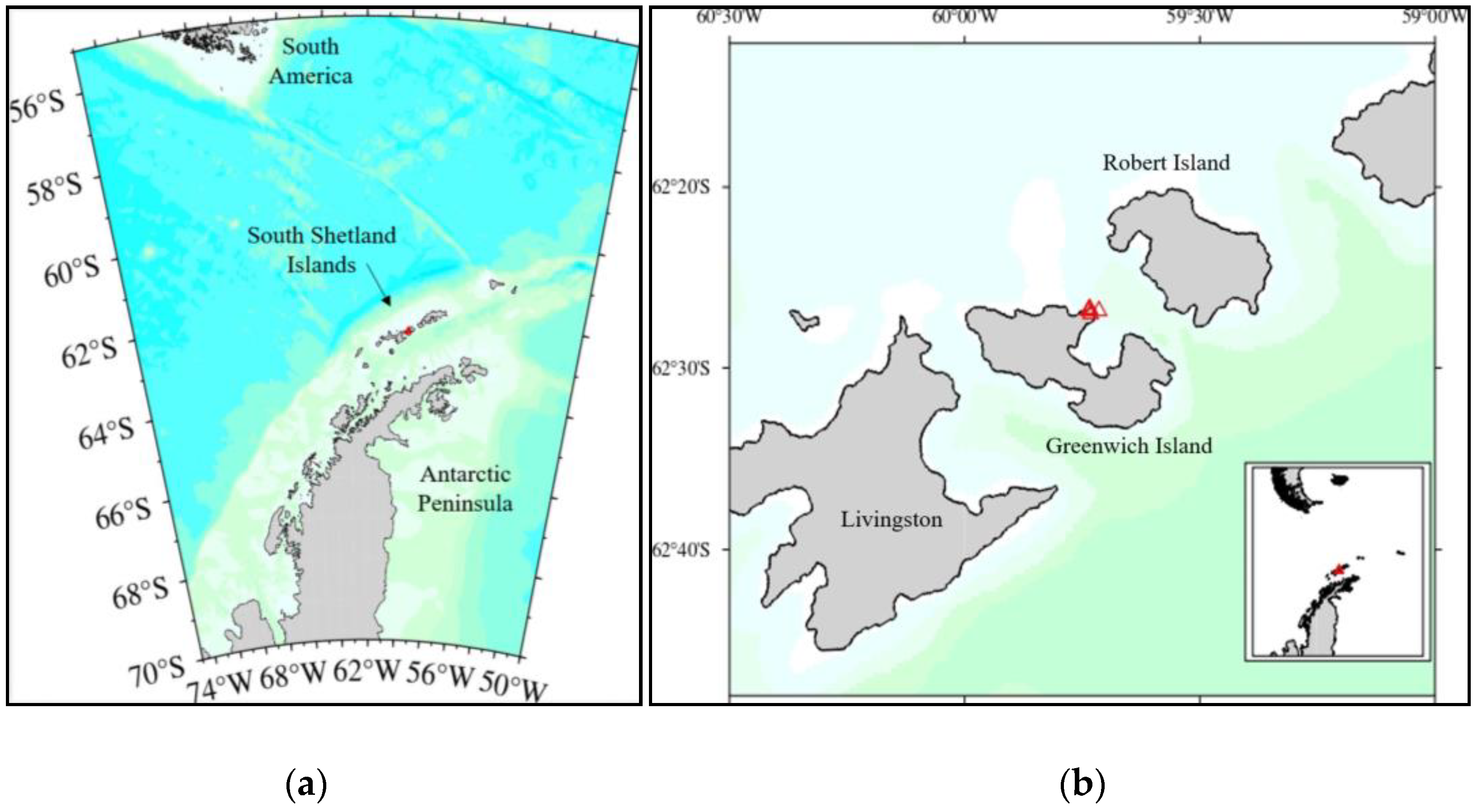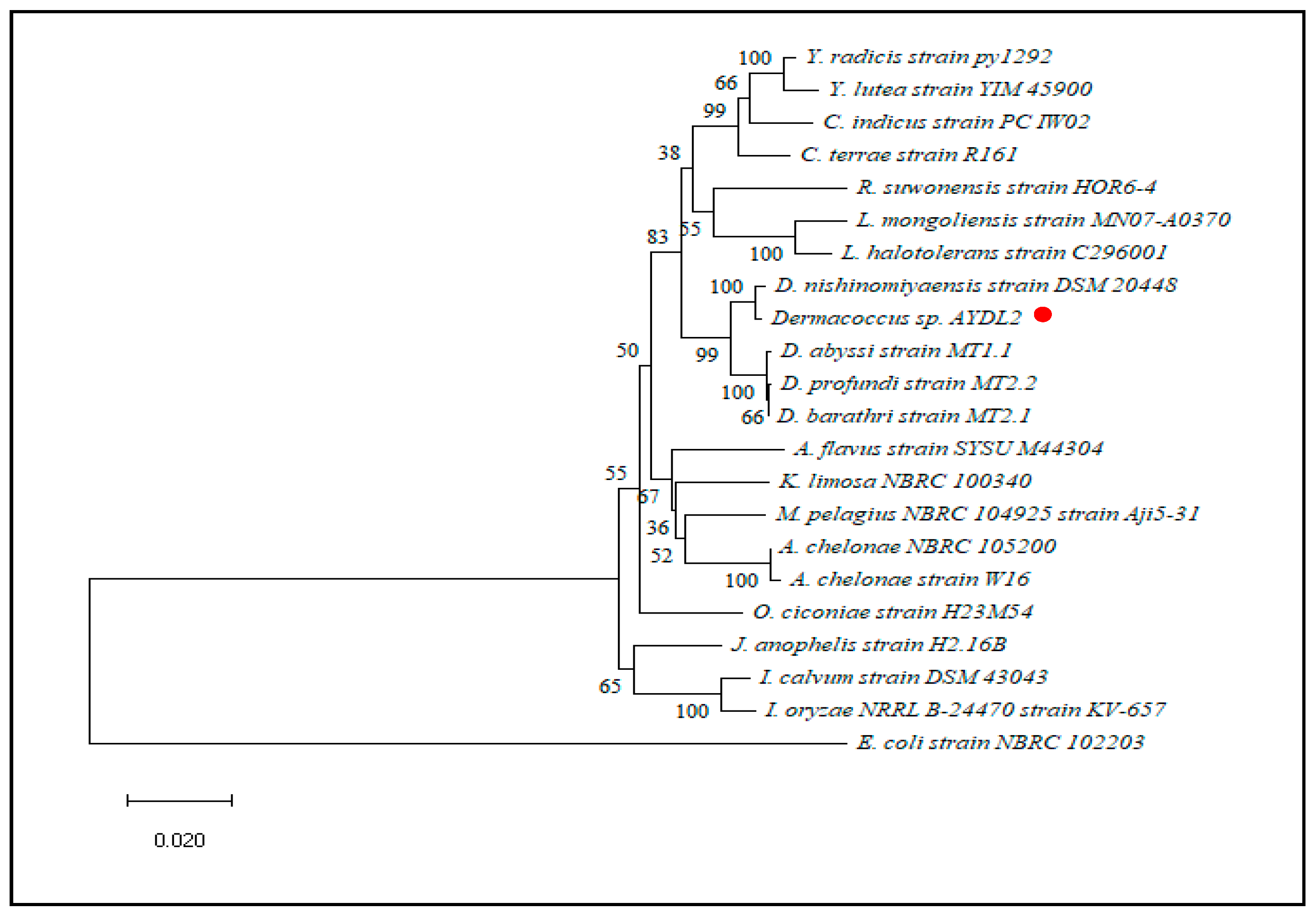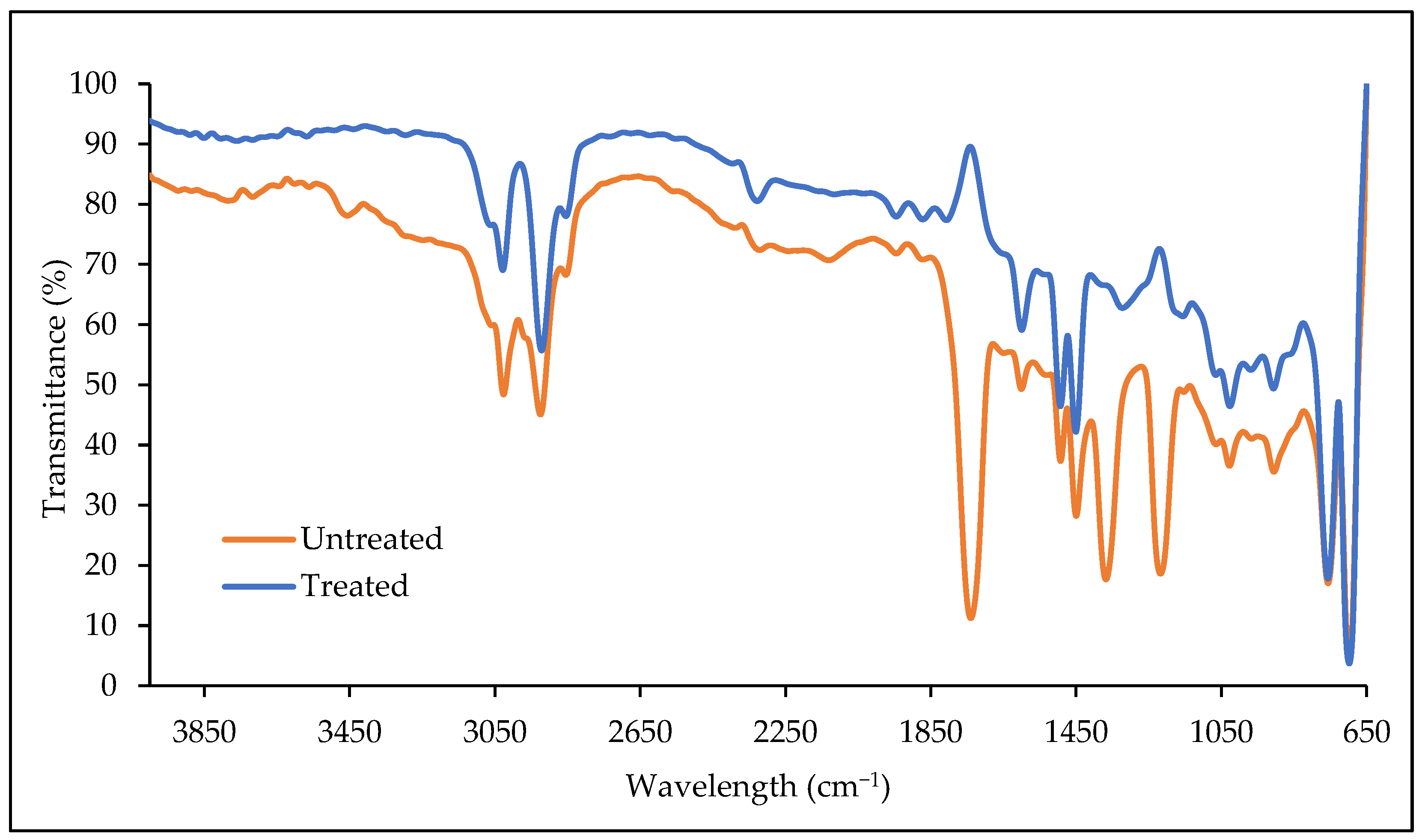Evaluation of the Deterioration of Untreated Commercial Polystyrene by Psychrotrophic Antarctic Bacterium
Abstract
:1. Introduction
2. Materials and Methods
2.1. Preparation of Polystyrene (PS) Microplastics
2.2. Isolation of the Antarctic Bacteria
2.3. Preliminary Screening of Isolates for PS Microplastics Utilisation
2.3.1. Determination of Weight Loss of Residual PS Microplastics
2.4. Strain Identification
2.5. Sequence and Phylogenetic Analysis
2.6. Assay for PS Microplastics Utilisation
2.7. Determination of Reduction Rate of PS Microplastics
2.8. Fourier Transform Infrared (FTIR) Analysis
2.9. Scanning Electron Microscope (SEM) Analysis
2.10. Statistical Analysis
3. Results and Discussion
3.1. Isolation and Preliminary Screening of Antarctic Bacteria for PS Microplastics Utilisation
3.2. Identification of PS-Utilising Strain
3.3. Assay of Polystyrene (PS) Microplastics Utilisation by AYDL1
3.4. FTIR Analysis of PS Microplastics
3.5. SEM Analysis of PS Microplastics
4. Conclusions
Author Contributions
Funding
Institutional Review Board Statement
Informed Consent Statement
Data Availability Statement
Acknowledgments
Conflicts of Interest
References
- Moore, C.J. Synthetic Polymers in the Marine Environment: A Rapidly Increasing, Long-Term Threat. Environ. Res. 2008, 108, 131–139. [Google Scholar] [CrossRef]
- Chen, Y.; Awasthi, A.K.; Wei, F.; Tan, Q.; Li, J. Single-Use Plastics: Production, Usage, Disposal, and Adverse Impacts. Sci. Total Environ. 2021, 752, 141772. [Google Scholar] [CrossRef] [PubMed]
- Chamas, A.; Moon, H.; Zheng, J.; Qiu, Y.; Tabassum, T.; Jang, J.H.; Abu-Omar, M.; Scott, S.L.; Suh, S. Degradation Rates of Plastics in the Environment. ACS Sustain. Chem. Eng. 2020, 8, 3494–3511. [Google Scholar] [CrossRef] [Green Version]
- Danso, D.; Chow, J.; Streit, W.R. Plastics: Environmental and Biotechnological Perspectives on Microbial Degradation. Appl. Environ. Microbiol. 2019, 85, e01095-19. [Google Scholar] [CrossRef] [PubMed] [Green Version]
- Pathak, V.M. Navneet Review on the Current Status of Polymer Degradation: A Microbial Approach. Bioresour. Bioprocess. 2017, 4, 15. [Google Scholar] [CrossRef] [Green Version]
- Ho, B.T.; Roberts, T.K.; Lucas, S. An Overview on Biodegradation of Polystyrene and Modified Polystyrene: The Microbial Approach. Crit. Rev. Biotechnol. 2018, 38, 308–320. [Google Scholar] [CrossRef]
- Khan, A.; Ali Shah, S.F.; Majeed, K.; Hameed, I.; Najam, M.; Hasan, M.; Ullah, M.; Khan, M.S.; Ahmad, Z.; Akhtar, M.S. Polymeric Membranes for Environmental Remediation: A Product Space Model Perspective. Chemosphere 2022, 304, 135236. [Google Scholar] [CrossRef]
- Amobonye, A.; Bhagwat, P.; Raveendran, S.; Singh, S.; Pillai, S. Environmental Impacts of Microplastics and Nanoplastics: A Current Overview. Front. Microbiol. 2021, 12, 3728. [Google Scholar] [CrossRef]
- Auta, H.S.; Emenike, C.U.; Fauziah, S.H. Screening of Bacillus Strains Isolated from Mangrove Ecosystems in Peninsular Malaysia for Microplastic Degradation. Environ. Pollut. 2017, 231, 1552–1559. [Google Scholar] [CrossRef]
- Ganesh Kumar, A.; Hinduja, M.; Sujitha, K.; Nivedha Rajan, N.; Dharani, G. Biodegradation of Polystyrene by Deep-Sea Bacillus paralicheniformis G1 and Genome Analysis. Sci. Total Environ. 2021, 774, 145002. [Google Scholar] [CrossRef]
- Mor, R.; Sivan, A. Biofilm Formation and Partial Biodegradation of Polystyrene by the Actinomycete Rhodococcus ruber. Biodegradation 2008, 19, 851–858. [Google Scholar] [CrossRef]
- Jacquin, J.; Cheng, J.; Odobel, C.; Pandin, C.; Conan, P.; Pujo-Pay, M.; Barbe, V.; Meistertzheim, A.-L.; Ghiglione, J.-F. Microbial Ecotoxicology of Marine Plastic Debris: A Review on Colonization and Biodegradation by the “Plastisphere”. Front. Microbiol. 2019, 10, 865. [Google Scholar] [CrossRef] [PubMed] [Green Version]
- Piehl, S.; Leibner, A.; Löder, M.G.J.; Dris, R.; Bogner, C.; Laforsch, C. Identification and Quantification of Macro- and Microplastics on an Agricultural Farmland. Sci. Rep. 2018, 8, 17950. [Google Scholar] [CrossRef] [PubMed] [Green Version]
- Scheurer, M.; Bigalke, M. Microplastics in Swiss Floodplain Soils. Environ. Sci. Technol. 2018, 52, 3591–3598. [Google Scholar] [CrossRef]
- Fuller, S.; Gautam, A. A Procedure for Measuring Microplastics Using Pressurized Fluid Extraction. Environ. Sci. Technol. 2016, 50, 5774–5780. [Google Scholar] [CrossRef] [PubMed] [Green Version]
- Zhou, Q.; Zhang, H.; Fu, C.; Zhou, Y.; Dai, Z.; Li, Y.; Tu, C.; Luo, Y. The Distribution and Morphology of Microplastics in Coastal Soils Adjacent to the Bohai Sea and the Yellow Sea. Geoderma 2018, 322, 201–208. [Google Scholar] [CrossRef]
- Mishra, A.K.; Singh, J.; Mishra, P.P. Microplastics in Polar Regions: An Early Warning to the World’s Pristine Ecosystem. Sci. Total Environ. 2021, 784, 147149. [Google Scholar] [CrossRef]
- Isobe, A.; Uchiyama-Matsumoto, K.; Uchida, K.; Tokai, T. Microplastics in the Southern Ocean. Mar. Pollut. Bull. 2017, 114, 623–626. [Google Scholar] [CrossRef]
- Bergami, E.; Rota, E.; Caruso, T.; Birarda, G.; Vaccari, L.; Corsi, I. Plastics Everywhere: First Evidence of Polystyrene Fragments inside the Common Antarctic Collembolan Cryptopygus antarcticus. Biol. Lett. 2020, 16, 20200093. [Google Scholar] [CrossRef]
- Habib, S.; Iruthayam, A.; Abd Shukor, M.Y.; Alias, S.A.; Smykla, J.; Yasid, N.A. Biodeterioration of Untreated Polypropylene Microplastic Particles by Antarctic Bacteria. Polymers 2020, 12, 2616. [Google Scholar] [CrossRef]
- Auta, H.S.; Abioye, O.P.; Aransiola, S.A.; Bala, J.D.; Chukwuemeka, V.I.; Hassan, A.; Aziz, A.; Fauziah, S.H. Enhanced Microbial Degradation of PET and PS Microplastics under Natural Conditions in Mangrove Environment. J. Environ. Manag. 2022, 304, 114273. [Google Scholar] [CrossRef] [PubMed]
- Altschul, S.F.; Gish, W.; Miller, W.; Myers, E.W.; Lipman, D.J. Basic Local Alignment Search Tool. J. Mol. Biol. 1990, 215, 403–410. [Google Scholar] [CrossRef] [PubMed]
- Saitou, N.; Nei, M. The Neighbor-Joining Method: A New Method for Reconstructing Phylogenetic Trees. Mol. Biol. Evol. 1987, 4, 406–425. [Google Scholar] [CrossRef] [PubMed]
- Jukes, T.H.; Cantor, C.R. Evolution of Protein Molecules. In Mammalian Protein Metabolism; Elsevier: Amsterdam, The Netherlands, 1969; pp. 21–132. ISBN 97814832-32119. [Google Scholar]
- Felsenstein, J. Confidence Limits on Phylogenies: An Approach Using the Bootstrap. Evolution 1985, 39, 783–791. [Google Scholar] [CrossRef]
- Campbell, I.B.; Claridge, G.G.C. (Eds.) Chapter 4 The Biology of Antarctic Soils. In Developments in Soil Science; Antarctica: Soils, Weathering Processes and Environment Series; Elsevier: Amsterdam, The Netherlands, 1987; Volume 16, pp. 73–96. [Google Scholar]
- Margesin, R.; Schinner, F. Properties of Cold-Adapted Microorganisms and Their Potential Role in Biotechnology. J. Biotechnol. 1994, 33, 1–14. [Google Scholar] [CrossRef]
- Sanin, S.L.; Sanin, F.D.; Bryers, J.D. Effect of Starvation on the Adhesive Properties of Xenobiotic Degrading Bacteria. Process Biochem. 2003, 38, 909–914. [Google Scholar] [CrossRef]
- Gómez-de-Mariscal, E.; Guerrero, V.; Sneider, A.; Jayatilaka, H.; Phillip, J.M.; Wirtz, D.; Muñoz-Barrutia, A. Use of the p-Values as a Size-Dependent Function to Address Practical Differences When Analyzing Large Datasets. Sci. Rep. 2021, 11, 20942. [Google Scholar] [CrossRef]
- Guermouche M’rassi, A.; Bensalah, F.; Gury, J.; Duran, R. Isolation and Characterization of Different Bacterial Strains for Bioremediation of n-Alkanes and Polycyclic Aromatic Hydrocarbons. Environ. Sci. Pollut. Res. 2015, 22, 15332–15346. [Google Scholar] [CrossRef]
- Wang, X.; Wang, X.; Liu, M.; Zhou, L.; Gu, Z.; Zhao, J. Bioremediation of Marine Oil Pollution by Brevundimonas diminuta: Effect of Salinity and Nutrients. Desalination Water Treat. 2016, 57, 19768–19775. [Google Scholar] [CrossRef]
- Sun, J.; Prabhu, A.; Aroney, S.T.N.; Rinke, C. Insights into Plastic Biodegradation: Community Composition and Functional Capabilities of the Superworm (Zophobas morio) Microbiome in Styrofoam Feeding Trials. Microb. Genom. 2022, 8, 000842. [Google Scholar] [CrossRef]
- Saul, D.J.; Aislabie, J.M.; Brown, C.E.; Harris, L.; Foght, J.M. Hydrocarbon Contamination Changes the Bacterial Diversity of Soil from around Scott Base, Antarctica. FEMS Microbiol. Ecol. 2005, 53, 141–155. [Google Scholar] [CrossRef] [Green Version]
- Friedrich, I.; Klassen, A.; Neubauer, H.; Schneider, D.; Hertel, R.; Daniel, R. Living in a Puddle of Mud: Isolation and Characterization of Two Novel Caulobacteraceae Strains Brevundimonas pondensis sp. Nov. and Brevundimonas goettingensis sp. Nov. Appl. Microbiol. 2021, 1, 38–59. [Google Scholar] [CrossRef]
- Debroy, A.; George, N.; Mukherjee, G. Role of Biofilms in the Degradation of Microplastics in Aquatic Environments. J. Chem. Technol. Biotechnol. 2022, 97, 3271–3282. [Google Scholar] [CrossRef]
- Wang, Z.; Xin, X.; Shi, X.; Zhang, Y. A Polystyrene-Degrading Acinetobacter Bacterium Isolated from the Larvae of Tribolium castaneum. Sci. Total Environ. 2020, 726, 138564. [Google Scholar] [CrossRef] [PubMed]
- Asmita, K.; Shubhamsingh, T.; Tejashree, S. Isolation of Plastic Degrading Micro-Organisms from Soil Samples Collected at Various Locations in Mumbai, India. Int. Res. J. Environ. Sci. 2015, 4, 77–85. [Google Scholar]
- Mohanan, N.; Montazer, Z.; Sharma, P.K.; Levin, D.B. Microbial and Enzymatic Degradation of Synthetic Plastics. Front. Microbiol. 2020, 11, 580709. [Google Scholar] [CrossRef] [PubMed]
- Lear, G.; Kingsbury, J.M.; Franchini, S.; Gambarini, V.; Maday, S.D.M.; Wallbank, J.A.; Weaver, L.; Pantos, O. Plastics and the Microbiome: Impacts and Solutions. Environ. Microbiome 2021, 16, 2. [Google Scholar] [CrossRef]
- Lumio, R.T.; Tan, M.A.; Magpantay, H.D. Biotechnology-Based Microbial Degradation of Plastic Additives. 3 Biotech 2021, 11, 350. [Google Scholar] [CrossRef] [PubMed]
- Lear, G.; Maday, S.D.M.; Gambarini, V.; Northcott, G.; Abbel, R.; Kingsbury, J.M.; Weaver, L.; Wallbank, J.A.; Pantos, O. Microbial Abilities to Degrade Global Environmental Plastic Polymer Waste Are Overstated. Environ. Res. Lett. 2022, 17, 043002. [Google Scholar] [CrossRef]
- Yanto, D.H.Y.; Krishanti, N.P.R.A.; Ardiati, F.C.; Anita, S.H.; Nugraha, I.K.; Sari, F.P.; Laksana, R.P.B.; Sapardi, S.; Watanabe, T. Biodegradation of Styrofoam Waste by Ligninolytic Fungi and Bacteria. IOP Conf. Ser. Earth Environ. Sci. 2019, 308, 012001. [Google Scholar] [CrossRef]
- Kim, H.-W.; Jo, J.H.; Kim, Y.-B.; Le, T.-K.; Cho, C.-W.; Yun, C.-H.; Chi, W.S.; Yeom, S.-J. Biodegradation of Polystyrene by Bacteria from the Soil in Common Environments. J. Hazard. Mater. 2021, 416, 126239. [Google Scholar] [CrossRef]
- Sekhar, V.C.; Nampoothiri, K.M.; Mohan, A.J.; Nair, N.R.; Bhaskar, T.; Pandey, A. Microbial Degradation of High Impact Polystyrene (HIPS), an e-Plastic with Decabromodiphenyl Oxide and Antimony Trioxide. J. Hazard. Mater. 2016, 318, 347–354. [Google Scholar] [CrossRef] [PubMed]
- Mohan, A.J.; Sekhar, V.C.; Bhaskar, T.; Nampoothiri, K.M. Microbial Assisted High Impact Polystyrene (HIPS) Degradation. Bioresour. Technol. 2016, 213, 204–207. [Google Scholar] [CrossRef] [PubMed]
- Yang, Y.; Yang, J.; Wu, W.-M.; Zhao, J.; Song, Y.; Gao, L.; Yang, R.; Jiang, L. Biodegradation and Mineralization of Polystyrene by Plastic-Eating Mealworms: Part 1. Chemical and Physical Characterization and Isotopic Tests. Environ. Sci. Technol. 2015, 49, 12080–12086. [Google Scholar] [CrossRef]
- Arsalan, M.; Rafiuddin. Synthesis, Structural Characterization, Electrochemical, and Electrical Study of Polystyrene-Based Manganous Tungstate Composite Cation Exchange Membrane. Desalination Water Treat. 2014, 52, 7531–7542. [Google Scholar] [CrossRef]
- Chaudhary, A.K.; Chaitanya, K.; Vijayakumar, R.P. Synergistic Effect of UV and Chemical Treatment on Biological Degradation of Polystyrene by Cephalosporium Strain NCIM 1251. Arch. Microbiol. 2021, 203, 2183–2191. [Google Scholar] [CrossRef]
- Hahladakis, J.N.; Velis, C.A.; Weber, R.; Iacovidou, E.; Purnell, P. An Overview of Chemical Additives Present in Plastics: Migration, Release, Fate and Environmental Impact during Their Use, Disposal and Recycling. J. Hazard. Mater. 2018, 344, 179–199. [Google Scholar] [CrossRef] [PubMed]
- Yeung, C.W.S.; Teo, J.Y.Q.; Loh, X.J.; Lim, J.Y.C. Polyolefins and Polystyrene as Chemical Resources for a Sustainable Future: Challenges, Advances, and Prospects. ACS Mater. Lett. 2021, 3, 1660–1676. [Google Scholar] [CrossRef]
- Ahmad Tarmizi, N.A.; Kasmuri, N. Reduction of Primary Microplastic in Nitrifying Medium under Closed System. Pertanika J. Sci. Technol. 2022, 30, 1601–1622. [Google Scholar] [CrossRef]
- Miloloža, M.; Ukić, Š.; Cvetnić, M.; Bolanča, T.; Kučić Grgić, D. Optimization of Polystyrene Biodegradation by Bacillus cereus and Pseudomonas alcaligenes Using Full Factorial Design. Polymers 2022, 14, 4299. [Google Scholar] [CrossRef] [PubMed]
- Brandt, J.; Mattsson, K.; Hassellöv, M. Deep Learning for Reconstructing Low-Quality FTIR and Raman Spectra—A Case Study in Microplastic Analyses. Anal. Chem. 2021, 93, 16360–16368. [Google Scholar] [CrossRef] [PubMed]
- Hou, L.; Majumder, E.L.-W. Potential for and Distribution of Enzymatic Biodegradation of Polystyrene by Environmental Microorganisms. Materials 2021, 14, 503. [Google Scholar] [CrossRef]
- Hidayat, T.R.; Indrawati, I.; Herlina, T. Styrofoam Biodegradation by Soil Bacteria Isolated from Landfill Site in Sarimukti Cipatat Bandung. Al-Kauniyah J. Biol. 2020, 13, 218–227. [Google Scholar] [CrossRef]
- Jiang, S.; Su, T.; Zhao, J.; Wang, Z. Isolation, Identification, and Characterization of Polystyrene-Degrading Bacteria from the Gut of Galleria Mellonella (Lepidoptera: Pyralidae) Larvae. Front. Bioeng. Biotechnol. 2021, 9, 736062. [Google Scholar] [CrossRef] [PubMed]






| Isolate | Initial Weight (g) | Final Weight (g) | Weight Loss (%) |
|---|---|---|---|
| Negative control | 0.200 | 0.199 ± 0.001 | 0.750 ± 0.354 |
| AYDL1 | 0.200 | 0.163 ± 0.003 | 18.50 ± 1.414 |
| AYDL2 | 0.200 | 0.175 ± 0.002 | 12.75 ± 1.061 |
| Day | Initial Weight (g) | Final Weight (g) | Weight Loss (%) | Removal Rate Constant, K (Day−1) | Half-Life (Days) |
|---|---|---|---|---|---|
| 0 | 0.2 | 0.2 | 0 | 0 | ∞ |
| 10 | 0.2 | 0.162 ± 0.001 | 19.3 ± 0.4 | 0.0211 | 33 |
| 20 | 0.2 | 0.163 ± 0.001 | 18.5 ± 0.7 | 0.0102 | 68 |
| 30 | 0.2 | 0.170 ± 0.000 | 15.0 ± 0.0 | 0.0054 | 128 |
| 40 | 0.2 | 0.164 ± 0.001 | 18.0 ± 0.7 | 0.0050 | 137 |
| Bacterial Strain(s) | Origin | Type of PS | Incubation Period | Temperature (°C) | Weight Loss (%) | Reference(s) |
|---|---|---|---|---|---|---|
| Rhodococcus ruber | Agricultural soil, Israel |
| 8 weeks | 35 | 0.8 | [11] |
| Bacillus subtilis | Various soils, India |
| 1 month | RT 1 | 58.82 | [37] |
| Staphylococcus aureus | 37.50 | |||||
| Streptococcus pyogenes | 11.11 | |||||
| Pseudomonas aeruginosa | n.d 2 |
| 30 days | 25 | 63.43 | [42] |
| Bacillus spp. | Soil from plastic dumping yard, India |
| 30 | 23.70 | [45] | |
| Pseudomonas spp. | <10 | |||||
| Enterobacter sp. | <4.0 | [44] | ||||
| Brevundimonas sp. | <3.0 | |||||
| Acinetobacter johnsonii | Soil from a trash-containing dump, Republic of Korea |
| 28 | 1.52 | [43] | |
| Pseudomonas lini | 1.45 | |||||
| Bacillus cereus | Mangrove soil, Malaysia |
| 40 days | 29 | 7.4 | [9] |
| Bacillus gottheilii | 5.8 | |||||
| Exiguobacterium sp. strain YT2 | Gut of mealworms (Tenebrio molitor) |
| 60 days | 22–24 | 7.4 ± 0.4 | [46] |
| Brevundimonas sp. AYDL1 | Soil, Antarctic |
| 40 days | 18 | 19.3 | This study |
Disclaimer/Publisher’s Note: The statements, opinions and data contained in all publications are solely those of the individual author(s) and contributor(s) and not of MDPI and/or the editor(s). MDPI and/or the editor(s) disclaim responsibility for any injury to people or property resulting from any ideas, methods, instructions or products referred to in the content. |
© 2023 by the authors. Licensee MDPI, Basel, Switzerland. This article is an open access article distributed under the terms and conditions of the Creative Commons Attribution (CC BY) license (https://creativecommons.org/licenses/by/4.0/).
Share and Cite
Tang, P.M.; Habib, S.; Shukor, M.Y.A.; Alias, S.A.; Smykla, J.; Yasid, N.A. Evaluation of the Deterioration of Untreated Commercial Polystyrene by Psychrotrophic Antarctic Bacterium. Polymers 2023, 15, 1841. https://doi.org/10.3390/polym15081841
Tang PM, Habib S, Shukor MYA, Alias SA, Smykla J, Yasid NA. Evaluation of the Deterioration of Untreated Commercial Polystyrene by Psychrotrophic Antarctic Bacterium. Polymers. 2023; 15(8):1841. https://doi.org/10.3390/polym15081841
Chicago/Turabian StyleTang, Pui Mun, Syahir Habib, Mohd Yunus Abd Shukor, Siti Aisyah Alias, Jerzy Smykla, and Nur Adeela Yasid. 2023. "Evaluation of the Deterioration of Untreated Commercial Polystyrene by Psychrotrophic Antarctic Bacterium" Polymers 15, no. 8: 1841. https://doi.org/10.3390/polym15081841






